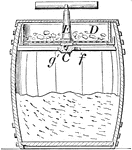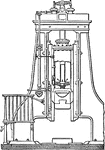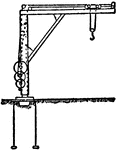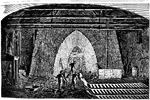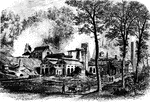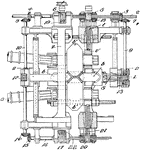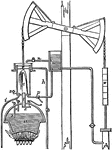The Iron and Steel Industry ClipArt gallery offers 75 illustrations furnaces and related equipment used in the iron and steel industries.
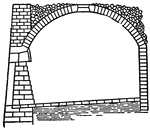
Beehive Oven
A primitive device of fire-brick, shaped like a beehive. It is simply filled with coal, part of which…

Bessemer Converter
"a Bessemer converter, which is an egg-shaped furnace built of wrought iron plates and lined with a…
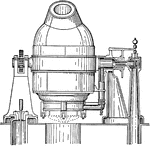
Bessemer Converter
Sir Henry Bessemer invented this furnace that creates "Bessemer steel" by burning carbon out of cast…

Bessemer Converting Vessel
"Bessemer Converting Vessel. Bessemer Steel is steel made direct from pig iron by a process patented…

Blast Furnace
A blast furnace measuring 42 feet high and 15 feet across that contains 4356 cubic feet of space.

Blast Furnace
A blast furnace measuring 47.5 feet high and 16.5 feet across that contains 6174 cubic feet of space.

Blast Furnace
A blast furnace measuring 55 feet high and 16 feet across that contains 7175 cubic feet of space.

Blast Furnace
A blast furnace measuring 58 feet high and 17 feet across that contains 8000 cubic feet of space.

Blast Furnace
A blast furnace measuring 60 feet high and 20 feet across that contains 12778 cubic feet of space.
Blast Furnace
A blast furnace measuring 75 feet high and 16.5 feet across that contains 11983 cubic feet of space.

Blast Furnace
A blast furnace measuring 80 feet high and 20.5 feet across that contains 15500 cubic feet of space.
Blast Furnace
A blast furnace measuring 95.5 feet high and 16 feet across that contains 15050 cubic feet of space.
Blast Furnace
A blast furnace measuring 95.5 feet high and 22 feet across that contains 25940 cubic feet of space.
Blast Furnace
A blast furnace measuring 95.5 feet high and 24 feet across that contains 28950 cubic feet of space.

Blast Furnace
A blast furnace measuring 85 feet high and 25 feet across that contains 26000 cubic feet of space.

Blast Furnace
A blast furnace measuring 90 feet high and 30 feet across that contains 41149 cubic feet of space.

Blast Furnace
A machine that blasts hot air to produce temperatures from 600 to 900 degrees Fahrenheit.
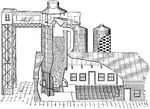
Blast Furnace for Cast Iron
"Iron ores are smelted in a blast furnace which is operated in a manner similar to that employed in…
!["A verticle section of one form of blast-furnace is represented [here]. the crucible (C) is the part of the furnace in which the molten matte and slag collect. The body of the furnace consists of two concentric shells (cs), made either of wrought iron or of steel, between which cold water (W) is caused to circulate to precent the inner shell becoming heated...Pipes called tuyeres (T) enter the furnace a short distance above the hearth...Above the body of the furnace extend the hood (H) and the stack (S). A door (D), used in charging the furnace, is placed in the hood." -Brownlee 1907](https://etc.usf.edu/clipart/35400/35491/blast_fur_35491_mth.gif)
Blast-furnace
"A verticle section of one form of blast-furnace is represented [here]. the crucible (C) is the part…
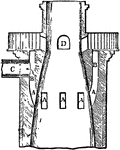
Collecting Top
"Prior to the introduction of the cup and cone, a form of tunnel-head in which no valve or cone exists…

Compound Riveted Girder (side by side)
A compound riveted girder is designed to bear a large load in a building or bridge, and is made of either…

Compound Riveted Girder (Vertical)
A compound riveted girder is designed to bear a large load in a building or bridge, and is made of either…

Bessemer Converter (Exterior)
An illustration of the exterior of the Bessemer converter. The Bessemer process was the first inexpensive…
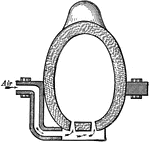
Bessemer Converter (Interior)
An illustration of the interior of the Bessemer converter. The Bessemer process was the first inexpensive…
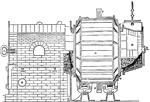
Danks Furnace
"Danks rotary Puddling Furnace. The feel is burnt in an ordinary fireplace, a blast B being admitted…

Ferrie's Furnace
"A peculiar furnace, known as Ferrie's self-coking furnace after the name of its inventor, in which…
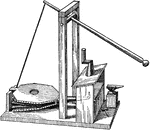
Forge
An illustration of a forge powered by a hand-bellows which forces air on glowing coals. A forge is a…
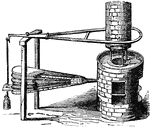
Nail forge
"Formerly, all nails were hand made, by forging on an anvil; and vast quantities are still made in this…
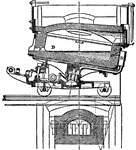
Forno-Convertisseur
"Ponsard Furnace or Forno-Convertisseur. This apparatus is essentially a combination of the Pernot furnace…

Furnace
"The section and ground plan of one of the older forms of open-mouthed furnaces used at Dowlais (Truran),…

Furnace
"The more modern furnaces are constructed like this, but the masonry at the base is still less massive,…
Furnace
"Any arrangement in which heat is produced by burning fuel. It usually is a structure of iron or brick,…

Furnace Hoist
"Gjers's Furnace Hoist. I. Section. II. Elevation. III. and IV. Plans." — The Encyclopedia Britannica,…
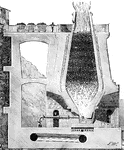
Blast Furnace
A blast furnace is a type of metallurgical furnace used for smelting to produce metals, generally iron.…

Blast Furnace
A furnace for smelting of iron from iron oxide ores; combustion is intensified by a blast of air

Crucible Furnace for Melting Metal
Crucible furnace used to melt metal. The stream of ignited gas enters the chamber to mix with air at…

Reverberatory Furnace
A reverberatory furnace is a metallurgical or process furnace that isolates the material being processed…
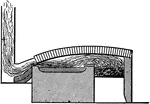
Sectional View of a Reverberatory Furnace
An illustration of a section of the reverberatory furnace. A reverberatory furnace is a metallurgical…
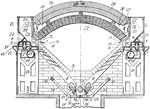
Smelting Furnace
An enclosed chamber in which heat is produced to heat buildings, destroy refuse, smelt or refine ores,…
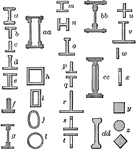
Girder
"Girders (in cross-section). a to l, wrought-iron girders; m to z, cast-iron girders; aa, box-girder;…
The Homestead Steel Works
Homestead Steel Works, located in Homestead, Pennsylvania, was a rival of the steel company, Carnegie…

I-Beam Girder
An I-Beam girder is a load bearing beam of steel or iron. It is shaped like a capital letter I.

Lift Hammer
The lift hammer is a large hammer used in forges. The hammer is tilted up and then allowed to drop.
Light Inverted Bow-String Girder (Elevation and Section)
This illustration shows a light inverted bow-string girder, as well as a section.
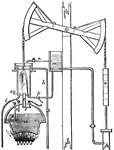
Newcomens Engine
"The simple outline of the atmospheric engine. Its mode of operation is as follows. Steam is admitted…

Parting Vessel
"The parting vessels are of porcelain which, to protect them against fracture by irregular heating,…

